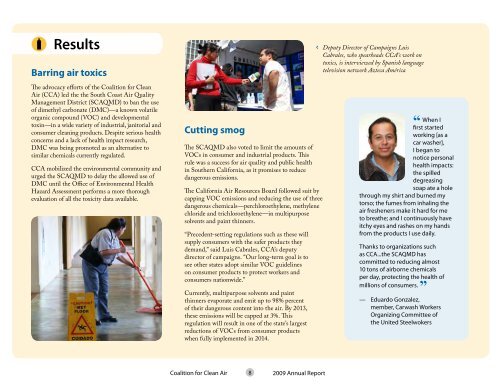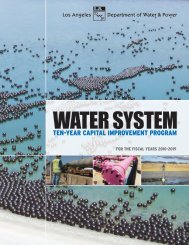The Road To Clean aiR - LA Differentiated
The Road To Clean aiR - LA Differentiated
The Road To Clean aiR - LA Differentiated
You also want an ePaper? Increase the reach of your titles
YUMPU automatically turns print PDFs into web optimized ePapers that Google loves.
j<br />
<br />
N<br />
Results<br />
Barring air toxics<br />
c ><br />
<strong>The</strong> advocacy efforts of the Coalition for <strong>Clean</strong><br />
Air (CCA) led the the South Coast Air Quality<br />
Management District (SCAQMD) to ban the use<br />
of dimethyl carbonate (DMC)—a known volatile<br />
organic compound (VOC) and developmental<br />
toxin—in a wide variety of industrial, janitorial and<br />
consumer cleaning products. Despite serious health<br />
concerns and a lack of health impact research,<br />
DMC was being promoted as an alternative to<br />
similar chemicals currently regulated.<br />
CCA mobilized the environmental community and<br />
urged the SCAQMD to delay the allowed use of<br />
DMC until the Office of Environmental Health<br />
Hazard Assessment performs a more thorough<br />
evaluation of all the toxicity data available.<br />
Cutting smog<br />
<strong>The</strong> SCAQMD also voted to limit the amounts of<br />
VOCs in consumer and industrial products. This<br />
rule was a success for air quality and public health<br />
in Southern California, as it promises to reduce<br />
dangerous emissions.<br />
<strong>The</strong> California Air Resources Board followed suit by<br />
capping VOC emissions and reducing the use of three<br />
dangerous chemicals—perchloroethylene, methylene<br />
chloride and trichloroethylene—in multipurpose<br />
solvents and paint thinners.<br />
“Precedent-setting regulations such as these will<br />
supply consumers with the safer products they<br />
demand,” said Luis Cabrales, CCA’s deputy<br />
director of campaigns. “Our long-term goal is to<br />
see other states adopt similar VOC guidelines<br />
on consumer products to protect workers and<br />
consumers nationwide.”<br />
Currently, multipurpose solvents and paint<br />
thinners evaporate and emit up to 98% percent<br />
of their dangerous content into the air. By 2013,<br />
these emissions will be capped at 3%. This<br />
regulation will result in one of the state’s largest<br />
reductions of VOCs from consumer products<br />
when fully implemented in 2014.<br />
<br />
Deputy Director of Campaigns Luis<br />
Cabrales, who spearheads CCA’s work on<br />
toxics, is interviewed by Spanish language<br />
television network Azteca América<br />
“ When I<br />
first started<br />
working [as a<br />
car washer],<br />
I began to<br />
notice personal<br />
health impacts:<br />
the spilled<br />
degreasing<br />
soap ate a hole<br />
through my shirt and burned my<br />
torso; the fumes from inhaling the<br />
air fresheners make it hard for me<br />
to breathe; and I continuously have<br />
itchy eyes and rashes on my hands<br />
from the products I use daily.<br />
Thanks to organizations such<br />
as CCA...the SCAQMD has<br />
committed to reducing almost<br />
10 tons of airborne chemicals<br />
per day, protecting the health of<br />
millions of consumers. ”<br />
— Eduardo Gonzalez,<br />
member, Carwash Workers<br />
Organizing Committee of<br />
the United Steelwokers<br />
Coalition for <strong>Clean</strong> Air<br />
<br />
2009 Annual Report





